#the topic of inner worlds can be a vast one so this one is specifically about going inside either intentionally or not
Explore tagged Tumblr posts
Text
CDD Writing Prompt: Entering Inner Worlds
I welcome everyone with a CDD to talk about their experiences, or write an excerpt on how they would like to see this aspect written in media :-)
If you don’t feel comfortable for any reason tying this to an account, feel free to send your writing through an ask on anon, just be sure to mention which prompt you’re referring to!
—————
I feel like there are many ways that this sort of thing can be portrayed because I’m certain that its different for everyone (even differing between parts). But it’s also one of those things that signals to me whether the author deals with dissociation themselves or not.. here are some tropes I’ve found with portraying a character going into their inner world, let me know if you’d write it similarly or differently:
In order for the character to enter the inner world, they must fully blackout switch into it
in order for the character to go into the inner world, they must be either nearly or fully asleep or in a trance-like state (like meditation or going through some trauma)
the character confusing the inner world with the real world (all senses feel realistic, all things seem tangible)
Alters other than the host having fully-running lives behind the host’s own, almost as if the inner world takes place in another dimension with the same sense of time and everything
There hard divide between being in the inner world vs outside of it
Being unable to know whats going on inside without intentionally going in
Alters in the inner world abide to real-life limitations (having to intentionally walk places, showing up as a full person with all their details, sometimes having to eat or sleep)
What are your thoughts on the topic? There aren’t as many examples as one may think about the inner world, even though it’d be vastly useful in storytelling to include.. but then, most DID media is about the discovery phase, so its rare they get to the point where they explore it
How would you write a character going into the inner world? If you have one, what does it feel like for you to go/look inside? How would you like to see it portrayed?
#inner worlds#dissociative identity disorder#actuallydid#did in media#complex dissociative disorder#otherwise specified dissociative disorder#cdd system#cdd inner world#did inner world#writing did#writing prompt#the topic of inner worlds can be a vast one so this one is specifically about going inside either intentionally or not#ill write about the tropes found in inner worlds another time perhaps
21 notes
·
View notes
Note
Life with Fyodor as your lover/s/o headcanons
Hello love, thank you very much for the request and I’m genuinely so sorry because it took me so long to answer it!❤️
I took it upon myself to write headcanons and a specific scenario because you had to wait so long.❤️
I hope you enjoy it nonetheless.❤️
+ The scenario I wrote for you is => HERE
Fyodor x ideal type fem!reader, yandere tendencies, unhealthy behaviour, lovesick!reader, husband!Fyodor, wife!reader, etc.

F Y O D O R D O S T O E V S K Y
FYODOR’S LIFE WITH HIS LOVER
Life with Fyodor is bound to be peaceful, harmonious, and serene.
However, it is also likely to be lonely, as long as Fyodor is focused on reaching his end goal.
It is essential for you to have your own interests and activities to pass the time because Fyodor won't be around all the time.
He has taken upon himself a great responsibility and goal, and he expects you to understand and cherish this when he steps down for you, declaring his undying love by showing you his vulnerability.
Accepting this means being comfortable with being by yourself for weeks, sometimes even months.
He will keep you in a vast mansion, circled by seemingly unending fields and private land, surrounded by thousands of security guards and cameras.
Only those he has brainwashed will be near you, as he doesn't trust anyone else.
Remember when Dazai said he doesn't trust anyone he can't manipulate? This rings very true for Fyodor.
Morally, you need to be at peace with his methods of ensuring your security. Beyond that, having a rich inner life is crucial to avoid boredom.
Fyodor would not like to see you fall into a depressive episode; he wants you to be joyous, always smiling prettily at him.
In his absence, you might enjoy indoor activities such as listening to music, reading, painting, or baking.
When he returns, he expects you to welcome him with open arms and an open heart. When he is there, you both feel complete.
You would spend intimate moments together, whether under the sheets, against the wall, or in the bathtub.
You would relax, read, and have meaningful, heartfelt conversations.
He would play the cello for you, his eyes meeting yours now and then, a warm and fuzzy feeling forming in his very soul as he meets your adoring, loving, almost lovesick gaze.
He would explain various topics you wish to hear about, and you would share in these discussions deeply.
Fyodor would love to taste your cooking, missing the scent of your homemade meals whenever he is away.
Contrary to what one might think, I believe Fyodor is prone to touchiness when truly, utterly in love. Not a clingy or overwhelming touchiness like Dazai or Nikolai, but a soft, gentle, heartfelt, and thoughtful touchiness. Sometimes even mildly mocking or wildly teasing.
As his partner and wife, you would hear his amused, deep, and intense chuckle now and then.
You would genuinely make him laugh and feel carefree in rare moments, moments he would deeply cherish until the day he dies.
Your life would become fuller when you finally have a baby (or babies).
You would become a loving mother, tending to your children and giving them the love they deserve.
You would compensate for Fyodor's occasional absence, but he would visit as often as his situation allows.
And when he reaches his goal, everything will be perfect.
He would rewrite reality to make his idealistic world worthy of God, including living as a loving husband and father, serving God as intended. ❤️
The scenario I wrote can be found HERE
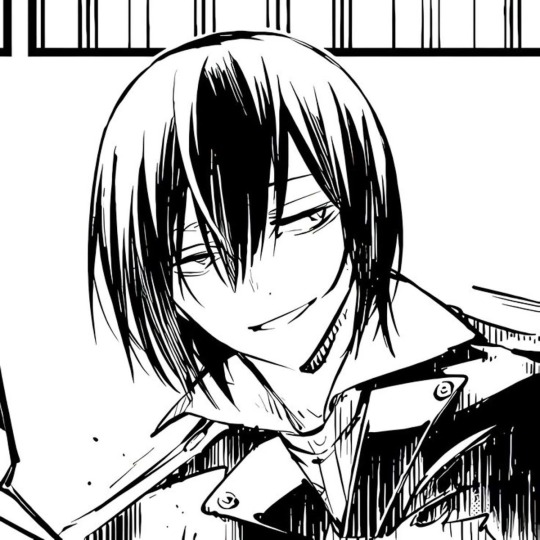

#bsd fyodor#bungou stray dogs fyodor#fyodor dostoevsky#fyodor dostoyevsky bsd#fyodor x reader#bungo stray dogs x reader#bungou stray dogs#fyodor x you#bsd#yandere bsd
146 notes
·
View notes
Text
A Word on DID Theory
The hot topic in the Stranger Things theory world lately is DID/systems. So lets put aside all my other theories for a moment, and let's talk about a blatant instance of dissociative amnesia and memory gatekeeping that we've already seen on screen.
Keep in mind that I'm not saying any of this is what actually happened, just that if we view things through the lens of "what if it's DID", this is what it looks like. Cool? Cool.
NINA.
El is a genuine dissociative amnesiac, textually speaking—whether it be that those memories aren't "hers" or that her mind buried them, she still has only snatches of recollection re: the Rainbow Room.
If we want to pursue a hypothetical DID lens, NINA-HNL could be considered El's headspace.
Many individuals with dissociative identity disorder (DID) have an internal world in which they or their alters can manifest as themselves and interact. These internal worlds, which are also known as inner worlds or headspaces, can range in size and complexity. A system with only a couple of alters might have an internal room in which alters that are internally active, awake, and aware might manifest. Others might expand this living room to include doors to bedrooms for groups of or individual alters. Others might have small towns that may even be filled with static "NPCs"...that can interact with alters but themselves are more similar to imaginary constructs than to actual alters or fragments. Even more expansive internal worlds can result when highly imaginative or dissociative systems use their inner world to retreat from the outside world and so play out entire stories within their mind. Different systems may have more or less control over their internal worlds. Some may be able to actively shape and add new aspects to their internal world while others may regulate this ability to a specific alter or groups of alters or find the task impossible. Some systems do not naturally have an internal world but may be able to create one with the help of therapy. (x)
(See also: The First Shadow as compared to NINA, with its objectively "fake" Hawkins, complete with partial sets and characters who mimic Henry in oddly specific ways)
NINA could be seen as a therapeutic method for helping El access her headspace and integrate her system. A key player in this process is Henry.
For El, Henry wears many hats.
Protector: Protectors are alters that protect the body, system, host, core, or other specific alters or groups of alters. Physical protectors might take or try to prevent physical abuse or become aggressive in an attempt to defend against physical abuse. Verbal protectors might take verbal abuse or lash back verbally in order to counter verbal abuse. Emotional protectors might take emotional abuse or comfort other alters to soften the effects of emotional abuse. Sexual protectors might take sexual abuse or attempt to instigate sexual abuse in an attempt to feel more in control of the situation. Caretaker alters are a unique type of protector that is focused specifically on taking care of younger, weaker, or more vulnerable alters or external children. Memory Holder: Memory holders are alters that hold memories that are usually traumatic in nature so that other alters do not have to be confronted by the memories. In some cases, memory holders might hold memories of childhood innocence or of being loved by the system’s otherwise abusive or neglectful family. In these latter cases, the memory holder might serve to preserve these memories untainted by memories of trauma or to avoid confronting the system with the pain of what the abuse has cost them. Memory holders are highly associated with abuse takers, alters that experience trauma so that other alters do not have to. Internal Self Helper: An internal self helper is an alter that holds vast amounts of knowledge about the system, alters, trauma, and/or internal workings. For those who believe in cores, internal self helpers are often viewed as the first alter to be created or as the normally pseudo-separate internal voice of logic and reason that all people possess. Within the theory of structural dissociation, internal self helpers are often viewed as observing parts or hidden observers, both less than distinct states. Internal self helpers may or may not also serve as a gatekeeper.
Obviously, Henry's main function would be that of a caretaker. He appears as an orderly, a literal caretaker:

And he's a source of protection, comfort, and support for El (at least, until she gets a little too close to the traumatic memories being withheld from her, but we'll talk about that later).
Henry also serves as a gatekeeper, a memory holder, an internal self helper, and various other types of protectors.
When Two is verbally bullying El, Henry reprimands him in response to protect El (This being distinct from the behavior of a persecutor, who may instead harm Two for his behavior. See: Brenner). When El "misbehaves" and uses Henry's advice/fuels her powers with emotion, Henry is punished instead while El is kept separate:

Henry, theoretically, serves as a verbal, physical, and emotional protector for El. El misbehaves, but she is not the one punished. El is bullied, but she is not the one who defends herself. In fact, as we see directly after Henry's punishment, El can't defend herself. She needs Henry to protect her. (Which is especially "fun" when her present-day memories bleed in, with Two and his buddies replicating Angela's bullying. El likely wished she had a protector then. Alas, she did not.)
Henry also holds memories for El, ones that Brenner himself claimed were temporarily inaccessible:

Lo and behold, there's Henry, telling El she needs to remember how to use her powers:

He also holds neutral-good memories bringing forward memories, and he brings them forward when he thinks they could help her achieve her goals:

Henry seems to hold immense amounts of knowledge about El (as a real-life caretaker/observer might), and he often serves as a strategist/logical planner for the things El wants to do.
However, if we want to really get into the weeds re: DID, then we must also consider One.
One could be the result of a polyfragmented system.
Polyfragmentation is when someone with DID has many subsystems and layers within their system.
Henry knows about One, and seems to be aware to some degree that One isn't "real", despite him technically existing. One serves all the same functions as Henry, save for one trait. One is a persecutor.
(Brenner serves many of the same functions as One, just to a different degree in terms of power, but I'll touch on that after I talk about One.)
Persecutor: Persecutors are alters that purposefully harm the body, system, host, core, or other alters, sabotage the system’s goals or healing, or work to assist the system’s abuser(s). Persecutors might hold self hatred or provide an outlet for internalized abusive and negative messages. They might believe that hurting the system or other alters is the only way to control them or teach them how to behave and so prevent further and more extreme abuse from outside abusers. They might be reenacting abuse or trying to ensure that future abuse isn’t more harmful due to being preceded by a period of relatively little abuse. Some persecutor alters are introjects of abusers and may or may not understand that they are not actually the abuser themselves. Gatekeeper: A gatekeeper is an alter that controls switching or access to front, access to an internal world or certain areas within it, or access to certain alters or memories. The existence of a gatekeeper is highly stabilizing for a system because gatekeepers can to some extent prevent unwanted switching, failure to switch when necessary, or failure to switch to the correct alter. They can help to prevent traumatic memories from bleeding from the alters who hold them to alters who could not yet handle them. Gatekeepers might police the boundaries between subsystems. Because gatekeepers have control over which alters have access to front, they themselves are often or always near front and so witness everything that happens to the system. They might experience vast amounts of abuse and might present as ageless, emotionless, and nonhuman as a way to process this and cope. Gatekeepers may or may not also serve as an internal self helper.
Both of them could be split from one alter—a Jekyll and Hyde split, almost. Where Henry helps El remember things in a cautious, supported way, One withholds memories and diverts El entirely to sabotage the healing process re: NINA, purportedly for El's safety. We could even theorize that the split between Henry and One lies solely in One's persecutorial nature, given that the other "jobs" double up between them.
One appears after Henry takes punishment for El.
We a distinct shift in goals and behaviors. One offers El unrestricted access to new areas of the inner world, something that Henry never made mention of wanting to do:

One quite literally gives her the key to enter new areas and experience new memories she could not access on her own. He does so after learning that Papa is planning to eliminate her after realizing she's powerful and uncontrollable.
Instead of facing this side-by-side with El and teaching her how to defend herself like Henry may have, One directs El to run and hide from it while he bears the burden of eliminating the "threats".


By eliminating fragments perceived as intra-system "threats", One acts as a persecutor in the name of being a protector.
It's essentially intrapsychosocial mutiny, attempting to release El from the Brenner-Alter's control and clear the rest of the fragments in the lab out of El's main accessible headspace altogether (as well as any memories of how she achieved that freedom).
Fragment: A fragment is an alter that is not fully differentiated or developed. Fragments may exist to carry out a single function or job, to hold a single memory or emotion, or to represent a single idea. Depending on the way that individual systems use the term, a fragment might be any alter that could not survive if left on its own or that could not pass for a fully developed individual without the help of other alters. Fragments usually have not been exposed to enough complex, different, or interactive experiences to incorporate more into their sense of self and so become more developed and differentiated.
(For all intents and purposes, the other lab kids, as well as the nurses and guards, would be fragments.)
This would leave just El/the "core" and Henry/One's little subsystem (into which he absorbed the remaining fragments of the system, save for the Brenner alter, who is too powerful):

This all ^ ^ could serve as a reason why El perceives One as having committed the massacre, despite her flashbacks showing something entirely different: her committing the massacre. It could also explain why the monologue physically could not have happened (it happened solely in El's headspace as a conversation between alters), and the overlap between Brenner's memories and El's pre-monologue memories.
This would make Vecna/One, then, a persecutor alter kicked out of El's headspace and given physical form by supernatural means during NINA—which could explain why he's so unwilling to hurt El in any meaningful way, his extensive female subtext, his obsession with finding/reconnecting with El in general, and his ability to open gates when El is the sole character to display that ability previously.
See also, pre-NINA:

See also:
If you have DID, you may find yourself doing things you wouldn't normally do, such as speeding, reckless driving, or stealing money from your employer or friend. But you feel compelled to do these things.


Nonetheless, taking control back from One during their little battle royale is what allowed El to get control of herself/her powers back—to a degree.
El still cannot handle being a "monster" in any way, shape or form. We see as much just before she enters the end of NINA:

Even before she went in, the only way it was going to end was by packing all her trauma into One and yeeting him out into a new dimension.
She still hasn't faced the real truth, which the real Brenner promises to show her. One has still, hypothetically speaking, managed to install false memories in El's mind, protecting her from the truth even as she banishes him from her mind along with her "real" memories of 1979.
She's not ready to face it.

Furthermore, we do see Vecna being directly compared to El, while the gang in Hawkins fights over what name they're meant to call him:

Even so far as Dustin going about fighting Vecna the same exact way he'd fight El:

For all intents and purposes, Henry/Vecna/One might as well be an "evil" duplicate of El—in terms of a DID theory, he could be a subsystem that El packed all her trauma into/blamed all of her childhood incidents on and kicked out of her head entirely.
Lastly, Brenner as a hypothetical persecutor, gatekeeper, and helper.
Brenner would be the lead/most powerful gatekeeper, since he's "Papa". He's the top-dog of the inner world, and he holds all the keys. He would be considered an introject of an abuser, one who repeatedly does harm to keep order within the system, one who holds all of El's past, and one who gatekeeps literally every single door in our hypothetical NINA "system".
This doubling of tasks between One and Brenner could account for One's "Brenner-isms", as El perceives them as serving similar functions despite the power differences between the two.
NINA Brenner is threatened by One, due to One's desire to take control of the total system away from him and share it between himself and El/the core. Whether that plot was for the better or worse, we'll never know. Brenner retains control, status quo resumes within the hypothetical system.

—————
P.S.— We've also seen in bts leaks of ST5, that Henry seems to have some kind of idyllic "normal" world. It wouldn't be a stretch to call it an inner world/headspace, especially if he himself is hiding or being gatekept from the rest of the hypothetical Henry/Vecna/One "system".
TFS, given its heavy similarities to NINA, could also be viewed through a system lens with Brenner as protector, persecutor, and memory holder—the Mindflayer being, in a hypothetical sense, an invading pseudo-alter.
#my take on DID theory since its popularity has seen an uptick#i know people looooove that theory for Will#but if anyone's going to be associated with DID...it's El. It's El and it's Henry#El already has canonical dissociative amnesia. So does Henry (TFS).#el hopper#henry creel#DID theory#st nina project
42 notes
·
View notes
Text
On Why I Identify as a Tulpa
This is a question that's come up a lot in the past, and so I thought it would be helpful to just have a single post I could link to whenever it comes up in the future.
Personal Experiences
Let's start here. I found the tulpa community when I was confused and didn't know what I was. The tulpa community were the first to tell me that I was real, and make me feel valid as a person. They helped introduce me to new skills and allowed me room to grow and learn about myself.
There was no hostility. No fakeclaiming. I was welcomed with open arms. I am eternally grateful to the tulpa community for giving the the room to grow.
A Vast Wealth of Resources
In the years since its creation, the tulpamancy community has amassed one of the largest reservoirs of knowledge of plural skills in existence, with over a hundred guides on how to create headmates, how to reinforce them, how to create and immerse yourselves in the inner world, how to impose, to switch, to partial possess.
There is no other plural community with this level of resources for endogenic systems. And one big reason for this is how they approach plurality...
Plurality as a skill and science...
Much of the endogenic community revolves around unquestioning acceptance. Every system is different. We don't need to know why. Just accept people as they are.
Spiritual systems especially don't try to explain their experiences because the experiences to them are something unexplainable.
The DID and OSDD community have their own resources, but those are generally focused on recovering from dissociative symptoms and working together better. Which is a great for them.
But the tulpamancy community is the only one that really approaches plurality as a skill to develop and train. We're the mad scientists. We're the ones who are pushing our understanding of the psychology of plurality forward by teaching practices that can induce hallucinations and dissociative experiences, and recording those experiences so others can learn from them.
I think tulpamancy is more than just making tulpas. It's a specific mindset associated with the tulpa community which isn't as present in other spaces.
Active research into endogenic plurality is focused on tulpamancy
This includes the upcoming FMRI study, which will be the first to ever to be conducted on any endogenic systems. It's important to support this research however we can, for all endogenic systems. And for me, that means identifying as a tulpa and helping others to take up the practice who are interested.
The origin of the appropriation claims are bad faith
The system who popularized this was an anti-endo. They say they're Buddhist, but they're not a Tibetan Buddhist, which is where the practice originated.
You won't find any Tibetan Buddhists outside of anti-endo and syscourse circles who are upset over the term. Certainly, no actual spiritual leaders have ever taken issue with it.
The Dalai Lama himself has said that other cultures can use Tibetan Buddhist meditations.
“Many Christians tell me they believe in Buddhist meditation, which can be learned by Christians. We teach right attitude. We teach meditation, which can be quite deep. These would be things that the West can take, and I think it is clear that Buddhists should practice certain Western methods, too.”
Here's an AMA with a Tibetan Buddhist practitioner who created an emanation.
And this paper details how the Western tulpa was created as a cultural exchange with the aid of Lama Kazi Dawa Samdup
Anti-Endos will attack any terms we use
The above anti-endo that pushed the claims about tulpamancy being appropriative also claimed the same about alternatives like "thoughtform."
»» CAN I USE “THOUGHTFORM”? «« If you’re using it seriously, I would prefer you didn’t. “Thoughtform”, as it is understood by westerners, originated from a misinterpretation of the term sprulpa.
Prominent anti-endos even started spreading the rumor that the term "endogenic," in relation to systems was first used by Freud dismiss DID as fake. (Endogenic itself was a response in opposition to older terms like "natural multiplicity" which medicalists claimed implied multiplicity caused by environmental factors was "unnatural.")
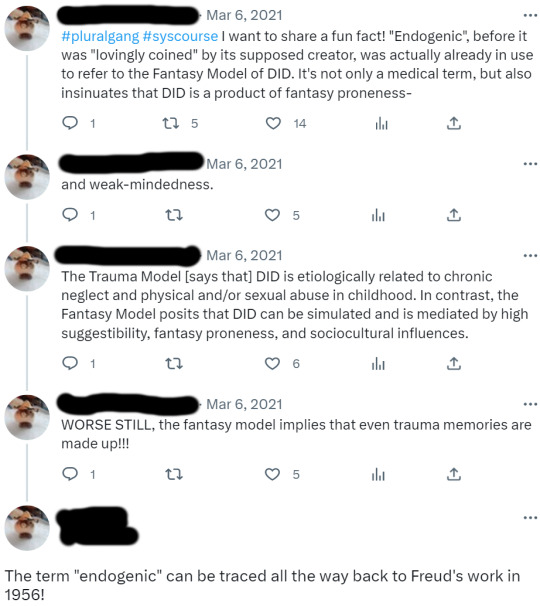
These claims were nonsense and meant to smear the endogenic community. Freud never said the word "endogenic," and "endogenic" and "endogenous" are common words in academic papers used in a variety of contexts to refer to things with internal origins.
Still, when a poll was made asking people's opinions on the term "endogenic," and that poll was circulated by anti-endos (including the ones who started the rumor in the first place,) more than 60% said that the current use of the term endogenic was harmful.

So in the end, it doesn't matter if you call yourself endogenic, a tulpa, thoughtforms or anything else. The people who want to hurt us will find an excuse to attack us and the language we use to define ourselves.
And this is why we cannot give ground on our terms. Why we cannot change ourselves, hoping for their acceptance. Because we will not be accepted as long as we exist in public, and this debate has never really been about the words we call ourselves but about our very existence.
If we call ourselves thoughtforms, then thoughtforms will become contentious, just as anti-endos have twisted "endogenic" into something contentious.
I believe that we have a duty to take a stand against those seeking to hurt us and our community.
#syscourse#tulpa#tulpamancy#plural#endogenic#plurality#system#multiplicity#plural system#systems#endogenic system#pro endo#actually plural#psychology#psychiatry#neurodivergent#willogenic#parogenic#pro endogenic#actually a system
75 notes
·
View notes
Text
What makes Baru Cormorant from The Masquerade Series the autistic girlie ever of all time? Here's what the people have to say:
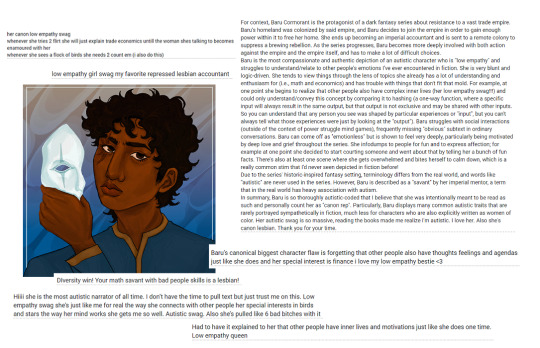
- Bracket art created by @anthyiess, used with permission. Baru-related asks/reblogs: x This post will be updated after each round!
Image ID in alt text and under the readmore.
[Image ID. White slide with a digital drawing of Baru holding a masquerade half-mask away from her own face. She is surrounded by text boxes which read,
"her canon low empathy swag whenever she tries 2 flirt she will just explain trade economics untill the woman shes talking to becomes enamoured with her whenever she sees a flock of birds she needs 2 count em (i also do this)"
"low empathy girl swag my favorite repressed lesbian accountant"
"For context, Baru Cormorant is the protagonist of a dark fantasy series about resistance to a vast trade empire. Baru's homeland was colonized by said empire, and Baru decides to join the empire in order to gain enough power within it to free her home. She ends up becoming an imperial accountant and is sent to a remote colony to suppress a brewing rebellion. As the series progresses, Baru becomes more deeply involved with both action against the empire and the empire itself, and has to make a lot of difficult choices. Baru is the most compassionate and authentic depiction of an autistic character who is "low empathy" and struggles to understand/relate to other people's emotions I've ever encountered in fiction. She is very blunt and logic-driven. She tends to view things through the lens of topics she already has a lot of understanding and enthusiasm for (i.e., math and economics) and has trouble with things that don't fit that mold. For example, at one point she begins to realize that other people also have complex inner lives (her low empathy swag!!!) and could only understand/convey this concept by comparing it to hashing (a one-way function, where a specific input will always result in the same output, but that output is not exclusive and may be shared with other inputs. So you can understand that any person you see was shaped by particular experiences or "input", but you can't always tell what those experiences were just by looking at the "output"). Baru struggles with social interactions (outside of the context of power struggle mind games), frequently missing "obvious" subtext in ordinary conversations. Baru can come off as "emotionless" but is shown to feel very deeply, particularly being motivated by deep love and grief throughout the series. She infodumps to people for fun and to express affection; for example at one point she decided to start courting someone and went about that by telling her a bunch of fun facts. There's also at least one scene where she gets overwhelmed and bites herself to calm down, which is a really common stim that I'd never seen depicted in fiction before! Due to the series' historic-inspired fantasy setting, terminology differs from the real world, and words like "autistic" are never used in the series. However, Baru is described as a "savant" by her imperial mentor, a term that in the real world has heavy association with autism. In summary, Baru is so thoroughly autistic-coded that I believe that she was intentionally meant to be read as such and personally count her as "canon rep". Particularly, Baru displays many common autistic traits that are rarely portrayed sympathetically in fiction, much less for characters who are also explicitly written as women of color. Her autistic swag is so massive, reading the books made me realize I'm autistic. I love her. Also she's canon lesbian. Thank you for your time."
"Baru’s canonical biggest character flaw is forgetting that other people also have thoughts feelings and agendas just like she does and her special interest is finance i love my low empathy bestie <3"
"Hiiii she is the most autistic narrator of all time. I don’t have the time to pull text but just trust me on this. Low empathy swag she’s just like me for real the way she connects with other people her special interests in birds and stars the way her mind works she gets me so well. Autistic swag. Also she’s pulled like 6 bad bitches with it"
"Had to have it explained to her that other people have inner lives and motivations just like she does one time. Low empathy queen"
"DIversity win! Your math savant with bad people skills is a lesbian!" End ID.]
59 notes
·
View notes
Text
I miss Snowdin (+ infodumping)
Lots of Papyrulkin shifts lately. Well, ever since I discovered this kintype, it's kinda became my new permashift (alongside my Red Death kintype).
Every once in a while during these shifts, I find myself thinking about my old home. As shitty and horribly dangerous as it was, I actually miss Snowdin. And to even think I'd say those words, yet here I am- I'm still very grateful to have Sanz with me in our system, but even if we try to bring Snowdin into our inner world, I know it just won't be the same.
I guess I never did explain much about my source, Darktale... It's an awful lot, too much for one post, but I'll infodump a bit about Snowdin since it's relevant.
cw: mention of death
Estimated Length: ~2 minutes
The village was mostly the same as classic Snowdin, only a lot darker. Lots of electrical outdoor lights. It wasn't uncommon to carry around an oil lantern, or any light source for that matter. With the near-constant snowfall and the dense woods encroaching everything, most of us either stayed inside or spent our time in Waterfall.
Snowdin's woods were the most dangerous part of the Underground. Sanz was the only one who went in and always came back alive. The entire woods consisted of tall, thick coniferous trees, a deep blanket of snow, and those... spirits. It was pitch dark. Ringing silence, occasionally broken by distant screeching.
They aren't monsters, nor anything related to humans. It was Sanz's job to keep their population "in check." At the time, I didn't know what he really did - the only hint I'd get would be the scratches and bites he usually came back with.
Alongside that job, Sanz studied them, both from afar and up-close. As he described them, "dark forces," they were composed of concentrated soul essence. Unlike us, monsters, and humans, they don't have souls. We don't know how they don't dissipate, let alone stabilize their form.
Dark forces can appear in different forms, but they still share the same characteristics - a translucent, black foggy body that floats a few feet off the ground; tiny, white beady eyes that glow brightly; a maw full of long, razor-sharp teeth; two disembodied hands with hooked claws... And they all have the same familiar screams. Even after so many years, it still sent shivers down my spine.
Monsterkind never ventured far into the woods. There was so, so little we knew. All we knew was how to survive, and even then, nature itself always fought back.
Power outages were too common. Since most of our light sources were electrical (we couldn't sustain long-lasting heat with the subzero cold), a power outage was the worst that could happen. Without light, dark forces can invade the village, attacking anyone in sight. There's no hiding, either. They hear everything. Smell everything. The only advantage is their poor sight, but seeing is useless when there's no lights.
Every power outage was a horrible experience with the same routine. I would help to get everyone indoors, while Sanz defended against the forces. There was always screaming, coming from both sides. When the power finally returns, the fresh snow was tinted pink, darker shades of red deeper below. If anyone was missing, we'd assume they died. At least that would've be merciful.
That's all from memory, or what I would've known at the time. Obviously, I know nearly everything about my universe now, considering... well, I'm the one who made it, lol... And that's just Snowdin. The vast majority of the Underground is different than classic, and I barely touched the topic of essence/matter, and dark/pure values. Not to mention, there's probably things Sanz can add here, too. Maybe he'll talk about his experiences on @thefangsystem, if he has the time.
(off-topic note: while typing this, our weather alarm was going off for a thunderstorm nearby. It was going off for hours by now, but this specific time, it suddenly spiked higher in volume and screeched static for almost a full minute. It was. fucking horrifying. and yeah I'm probably not gonna sleep tonight FHJGJFGJHH /hj)
#kin.suv#write.suv#fictionkin#fictionkind#ockin#papyrulkin#monsterkind#undertale kin#darktale au#infodump#cw death#tw death
2 notes
·
View notes
Text
Psychopharmacology The British Association of Psychopharmacology (BAP)(n.d.) is a scholarly society and enlisted philanthropy. It advances exploration and instruction in psychopharmacology and related zones, and unites individuals in the educated community, well-being administrations, and industry. Shaped in 1974, it is the biggest such national relationship in Europe, and the second biggest in the world. The website has a lot of different content available that would help me in my coursework. Several articles can be seen in the homepage, which have been published by renowned authors. Videos are also available that would help me in understanding difficult concepts of psychopharmacology. The association has its own journal and publications which are available completely if one becomes a member of the British association. The homepage also presents several tweets by BAP that creates a good impact on the visitor. BAP provides several activities to the members of the website and also includes detailed information for the public so that it's not just the members who benefit from the site, but also the general public. Furthermore, the site provides links and information about new books that can help students and researchers alike. The website also provides information of events and conferences related to psychopharmacology, which gives opportunities to the students to learn and interact more and excel in different topics of pharmacology. Moreover, there are different training and education programs, including Masterclasses that provide training to nurses, pharmacists etc. The website provides a lot of opportunities for the trainees and students thus it has a lot of positive points. Every part of information is given in detail to not only help the people related to psychopharmacology, but also the general public. The vast numbers of articles represent the importance of BAP among the profession. BAP integrates well into the coursework and would not only help in providing ample information, but also opportunities for the emerging pharmacologists. Part II Factors in Treating Depression in the Elderly The video tells that there are several factors that need to be considered in elderly depression. Different medicinal side effects occur because an elderly's brain is damaged, resulting in memory problems, broken bones etc. Extrapyramidal side effects cause gait problems, tremors, muscle spasms, and inner restlessness. Drug issues present that create side effects include: Paxil and Prozac. The presenter provides detailed information about the side effects of elder people suffering from dementia; so it is very relevant and helpful to the coursework; however, I would like to learn more about substitute medicines if the given one has severe side effects (Nickel, 2010). Limits of Pharmacological Treatment The video starts with drug development that mentions RU 4 ME drug that improves judgment of single women about to have sex with eligible seeming men, and Perceptia, which induces euphoric acceptance of hair loss, weight gain, impotence and other natural symptoms of aging; side effects may include verbal seepage. Apart from that, the presenter does not clear anything about the limitations of pharmacological treatment that could be of any use in the coursework. Nickel (2010) talks about psychologists who prescribe medications that will be seen in the future and I would like to learn more about why the psychologists who are not allowed to prescribe medicines in their profession would do so in the future. Specifics in Treating Depression The video talks about antidepressants, including Anergic Depressions in which a combination of Remeron and Ritalin is taken by the patients. Remeron is also used as a sleeping pill for insomnia and helps people go to sleep, but also causes hypertension when the person wakes up. Weight loss is common in the elderly, so Remeron helps them to have the urge of eating and gain weight. Agitated Depressions is another form of depression that can also be treated with Remeron and SSRIs. Psychotic depression is very common and the patient should use AD and anti-psychotics for treatment. Nickel (2010) also gave an example of a personal experience which cleared up a lot of queries regarding psychotic depressions. In this topic, I would also like to learn more about the substitute medicines that can be given if the ones being taken have severe side effects like increased hypertension. Polypharmacy Cascade The video starts with a case study that includes a 78-year-old woman recovering from a hip fracture. She has cognitive impairment, mild high blood pressure and urinary incontinence; her medicinal routine included Ativan 0.5 mg, and Lorazepam 0.5 mg, both of which are the same medicines with different names. The presenter explaining the case gives a clear explanation of how wrong medicinal treatment can cause the pain to get worse instead of being healed (Nickel, 2010). I would like to learn further about how the situation could be avoided in the first hand and the role the psychopharmacology association plays in this regard. Part III Borderline Personality Disorder The distinctive subtypes of borderline personality disorder incorporate schizophrenia, rejection sensitivity, anger, impulsiveness and instability. Nickel (2010) clarifies that the schizophrenic dislikes being within the sight of a specialist, we see a less number of individuals amid the profession looking for treatment. Each subtype is clarified in point of interest alongside cerebrum exercises and treatment impacts of each subtype. The presenter clearly defined the mentioned subtypes, but I would like to learn a detailed description of the treatment of each of them. ADHD The video begins with the chronicled diagnosis of ADHD, which began in 1902 and included imperfections, indications and the finding required for ADHD. The address likewise clears that ADHD is hereditary and can be passed on to children. The pervasiveness rate of ADHD in youngsters is 5 to 7% while in grown-ups it is 4%; among which 20% is gained while 8% is hereditary. The presenter gave an authentic and factual part of the video, which is vital to learn so as to know more about ADHD and I might want to take in more about the Acquired portion of ADHD as it would make me all the clearer about how youngsters can secure ADHD (Nickel, 2010). Depression and Dementia Depression has a great deal of danger variables as it profoundly influences the mind, driving towards dementia. There is an enormous measure of cover amongst dementia and discouragement alongside Parkinson's disease, and Alzheimer's. Depression in later stages can prompt forceful conduct, loss of weight, and physical hallucinations. The illness spreads moderately and takes up to 12 to 14 years until the individual kicks the bucket. The individual influence loses the capacity to nurture himself or herself, and they totally depend on other individuals for each and every thing. The presenter gave a nitty gritty clarification of depression and dementia and would be extremely helpful for the aversion of the turmoil (Nickel, 2010). I would like to know more about how the situation can be recognized at the start so it can be controlled before spreading further. Autism Spectrum Disorders Oxytocin is essential for kids amid work and improves social learning in them. Nickel (2010) presents and contemplates a discussion about Asperger's, and the general population influenced with it is exceptionally clever and can see tones in more passionate ways (Nickel, 2010). I might want to take in more about Nasal infusion, as the study sounded exceptionally intriguing and something that could be examined on additional. Bibliography British Association of Psychopharmacology. (n.d.). Retrieved from Nickel, T. (2010). Factors in Treating Depression in the Elderly.Youtube.com. Retrieved from: https://www.youtube.com/watch?v=_dQfbdLgztQ&index=22&list=PL58291C0D6F73D49D Nickel, T. (2010). Specifics in Treating Depression.Youtube.com. Retrieved from: https://www.youtube.com/watch?v=vPDWjE2iLnQ&index=20&list=PL58291C0D6F73D49D Nickel, T. (2010). Limits of Pharmacology Treatment.Youtube.com. Retrieved from: https://www.youtube.com/watch?v=4rAB54LVywI&index=21&list=PL58291C0D6F73D49D Nickel, T. (2010). Polypharmacy Cascade. Youtube.com. Retrieved from:https://www.youtube.com/watch?v=vncxdR729zc&index=19&list=PL58291C0D6F73D49D Nickel, T. (2010). Depression and Dementia.Youtube.com. Retrieved from: https://www.youtube.com/watch?v=NczlDr8PjM&index=18&list=PL58291C0D6F73D49D Nickel, T. (2010). ADHD.Youtube.com. Retrieved from: https://www.youtube.com/watch?v=6HbercPYv7w&list=PL58291C0D6F73D49D&index=3 Nickel, T. (2010). Autism Spectrum Disorders.Youtube.com. Retrieved from:https://www.youtube.com/watch?v=XI9wloxiGUE&list=PL58291C0D6F73D49D&index=9 Nickel, T. (2010). Borderline Personality Disorder.Youtube.com. Retrieved from:https://www.youtube.com/watch?v=HPuIPDJAysY&index=13&list=PL58291C0D6F73D49D Read the full article
0 notes
Text
Explore Your Future with a B.Tech Specialization: Unlock Endless Possibilities
Choosing the right path for your education is a big decision, especially when it comes to a field as dynamic and exciting as technology. If you’re interested in building a bright future filled with innovation and opportunities, a B.Tech Specialization might be the perfect fit for you!
But what exactly is a B.Tech Specialization? Simply put, it’s a Bachelor of Technology degree where you focus on a specific area of study within the vast field of technology. Whether you’re passionate about computer science, electronics, mechanical engineering, or any other tech-related field, a B.Tech Specialization allows you to dive deep into the subject you love the most. This means you don’t just learn the basics; you gain advanced knowledge and skills that set you apart in the industry.
Imagine spending your college years exploring the inner workings of the technology that powers our world. With a B.Tech Specialization, you’ll get hands-on experience with the latest tools and techniques, preparing you for the real-world challenges that tech professionals face every day. Whether it’s designing cutting-edge software, developing innovative hardware, or solving complex engineering problems, your specialization will give you the expertise to make a difference.
One of the best things about a B.Tech Specialization is the variety of options available. You can choose from a wide range of specializations, depending on your interests and career goals. For example, if you’re fascinated by computers and how they work, a specialization in Computer Science could be perfect for you. Here, you’ll learn about programming, artificial intelligence, and cybersecurity, among other exciting topics. Or, if you’re more interested in how machines and devices are built, a specialization in Mechanical Engineering could be your calling. This path will teach you about design, manufacturing, and the principles that make machines work.
But the benefits of a B.Tech Specialization don’t stop at just learning. By focusing on a specific area, you’ll also open doors to numerous career opportunities. Companies today are looking for experts—people who have in-depth knowledge in particular fields. With a specialized degree, you become more than just a graduate; you become a specialist who is ready to take on advanced roles in top companies, research institutions, or even start your own tech venture.
Moreover, a B.Tech Specialization can also pave the way for further studies. If you ever decide to pursue a master’s degree or even a Ph.D., having a strong foundation in your chosen specialization will make you well-prepared for the advanced topics and research work. It’s a stepping stone to not just a successful career, but also a lifetime of learning and growth.
For parents and students alike, understanding the importance of a B.Tech Specialization is crucial. It’s not just about getting a degree; it’s about choosing a path that aligns with your passions and prepares you for the future. In today’s fast-paced world, having specialized knowledge gives you an edge, making you more competitive in the job market.
So, if you’re ready to embark on an educational journey that’s both challenging and rewarding, consider a B.Tech Specialization. It’s your chance to explore your interests, build valuable skills, and create a future full of possibilities. The world of technology is ever-evolving, and with the right specialization, you’ll be at the forefront of these exciting changes.
0 notes
Text
Why is life so meaningless?
I ask this not even in some emo way, but literally, life is practically meaningless when you think about it?
People live, and then they die. That's it. No matter what you do in life, who you are, we will all die one day
But then what? Even if there truly is an afterlife, it's still meaningless. In christianity, you either go to heaven or hell. In heaven, you supposedly gain eternal life, but honestly who would want eternal life?
No matter how fun and free you feel at the beginning, you'll run out of things to do eventually. Interactions would turn meaningless, you’ve spoken about every topic, and you've already tried every activity on the list. You'll still age mentally and then life after death would just turn into internalised death — if that makes sense? You'd be essentially dead inside after a few centuries at most
In buddhism, they believe in reincarnation. But to reincarnate is to lose your memories, and your background. At that point, is it even you? What makes every human being unique is their inner code of self-conduct and their upbringing. If you take away the very specific childhood and people around you from your reincarnate, then that might as well be a whole new person. It just won't be you
In all religions, the afterlife is either eternal life wherever or 'another life' that isn't even your life. In which case, I would much rather believe that once we die, we just die. We came from nothing, and we revert to nothing. End of story.
But then, if we only have one life, is there even a point to it at all? No matter what we do, we will die. That is a fact, unless technology advances so far to the point we become immortal, which at that point humanity would probably be run by robots or something so no thank you.
Why do we continue to live when it'll all be for nothing? Most people have goals—ambition. But some don't. So what do we have keeping us going? Nothing. The only thing I could possibly think of that could drive us to live, is love
I think that’s why I’m actually so fucking delusional
I'm a realist at heart, but without my insane imagination, I think I'd truly just be dead inside. I need my delusional fantasies — the hope of the possibility that I can one day meet someone who can change it all. Someone who I can live for, and someone who will live for me.
I make imaginary scenarios where a knight in shining armour will one day just magically come waltzing into my life and make my life worth living. I fantasize about nearly every person I see, regardless of whether we’ve ever even spoken because of the fact that I know I’ll have to idealize a whole person in my head since I know I'll never meet someone who'll live up to my unrealistic desires, at least not someone who would be willing to like me back.
But just the thought that it's a possibility, a possibillity that someone is out there for me keeps me looking forward to meeting new people, and life in general
I think, that's why most people are willingly delusional nowadays. Because the standards of people have gone so low that the vast majority of them aren't even decent human beings, leading people to need to fantasize this whole 'idealistic' image of someone knowing it’s probably not even true in the slightest
But hey that's just a theory, A FOOD THEORY
Off topic but this is why Robin’s backstory from one piece resonates with me so much. I don’t relate to her in the slightest, but Saul’s line to her hit hard. “Nobody in this world is born to be alone.” Man.
I love one piece
0 notes
Text
Unlocking Spiritual Growth: The Importance of Bible Reading Plans
In today's fast-paced world, finding time for spiritual nourishment can be a challenge. Amidst the chaos of daily life, it's easy for our spiritual well-being to take a backseat. However, nurturing our faith is essential for personal growth and inner peace. One powerful way to deepen our connection with the divine is through regular Bible reading. But with so many verses and chapters, where do we start? This is where Bible reading plans come in, offering structure and guidance on the journey of spiritual exploration.

Bible reading plans are carefully curated schedules designed to help individuals navigate the vast terrain of scripture. Whether you're a seasoned believer or a newcomer to the faith, these plans offer a roadmap for engagement with the Word of God. They provide a systematic approach, breaking down the Bible into manageable portions and offering insights to enhance understanding.
One of the key benefits of Bible reading plans is consistency. By following a prescribed schedule, readers develop a habit of daily engagement with scripture. This regularity fosters spiritual discipline, deepening our understanding of God's message and strengthening our relationship with Him. Just as physical exercise requires consistent effort to yield results, consistent Bible reading cultivates spiritual growth over time.
Moreover, Bible reading plans offer variety and flexibility. They come in various formats, catering to diverse preferences and needs. Some plans focus on specific themes or topics, such as love, forgiveness, or leadership, providing a targeted exploration of relevant passages. Others take readers through the Bible chronologically, tracing the unfolding narrative of God's plan for humanity. Whether you prefer a structured approach or a more fluid one, there's a reading plan to suit every individual.
Additionally, Bible reading plans foster community and accountability. Many churches and religious organizations offer group reading plans, encouraging members to embark on the journey together. Sharing insights and reflections with fellow believers enhances understanding and strengthens communal bonds. Moreover, accountability partners can help individuals stay on track with their reading goals, providing encouragement and support along the way.
Furthermore, Bible reading plans promote depth of understanding. By guiding readers through a systematic exploration of scripture, these plans encourage thoughtful reflection and study. Instead of merely skimming the surface, readers delve into the rich layers of meaning embedded within the text. They uncover connections between passages, discern recurring themes, and gain a deeper appreciation for the overarching narrative of salvation history.
Beyond intellectual understanding, Free Bible Reading Plans facilitate spiritual transformation. As readers immerse themselves in God's Word, they encounter truths that challenge, convict, and inspire. The Holy Spirit works through scripture to illuminate minds and transform hearts, conforming believers more closely to the image of Christ. Through prayerful reflection and meditation, readers internalize biblical principles, allowing them to manifest in their thoughts, words, and actions.
0 notes
Text
Understanding Workshop Manuals: A Comprehensive Guide
A workshop manual is more than just a book; it's a guide that holds the secrets to the inner workings of your vehicle. Whether you're a seasoned mechanic or a passionate car owner who loves getting their hands dirty, a workshop manual is an invaluable resource.
Comprehensive Information: One of the key features of a workshop manual is its comprehensive nature. It covers a vast array of topics, from routine maintenance procedures to complex engine overhauls. No matter the make or model of your vehicle, these manuals are tailored to provide step-by-step instructions for various tasks.
Vehicle Specifics: Workshop manuals are often tailored to specific makes and models. This level of detail is crucial because it means you're not sifting through irrelevant information. Whether you're working on a vintage beauty or a modern marvel, there's likely a workshop manual designed specifically for your vehicle.
Maintenance Guidance: Regular maintenance is the cornerstone of a healthy vehicle, and workshop manuals excel in providing detailed maintenance schedules. They guide you through oil changes, brake pad replacements, and other routine tasks, ensuring your vehicle remains in top-notch condition.
Troubleshooting: Every vehicle owner has faced that dreaded moment when a mysterious noise or a sudden malfunction occurs. Workshop manuals are equipped with troubleshooting guides, helping you identify and resolve issues efficiently. It's like having a mechanic whispering solutions in your ear.
Cost-Effective Repairs: While taking your vehicle to a professional is sometimes necessary, a workshop manual empowers you to tackle many repairs on your own. This not only saves you money on labor costs but also instills a sense of accomplishment as you witness your skills and knowledge grow.
Understanding Your Vehicle: A workshop manual is a treasure trove of information about your vehicle's anatomy. It's not just about fixing problems; it's about understanding how your vehicle operates. This knowledge can deepen your appreciation for your car and make you a more informed and confident owner.
DIY Friendly: Workshop manuals are crafted with the do-it-yourselfer in mind. With clear illustrations, detailed diagrams, and user-friendly language, they bridge the gap between professional mechanics and those who are just starting to explore the world of vehicle maintenance.
Safety First: Safety is paramount when working on any vehicle, and workshop manuals emphasize this aspect. They provide essential safety precautions, ensuring that you approach each task with the necessary caution and protective measures.
In conclusion, a workshop manual is not just a manual; it's your trusted companion in the journey of maintaining and understanding your vehicle. Whether you're changing spark plugs, rebuilding an engine, or simply performing routine checks, having a workshop manual by your side is like having a knowledgeable friend guiding you every step of the way. So, embrace the wealth of information these manuals offer, and let your inner mechanic thrive.
1 note
·
View note
Text
MCU’s Ennead
So I was re-watching the first episode of Moon Knight today, and I started overthinking things (as one does). In the scene where Steven’s doing inventory with Donna, he tells her marketing screwed up the promotion, and the posters only show seven members of the Ennead when there should be nine, right? And we don’t get a good look at the posters, so we don’t know who’s been left out, but we do learn who’s in the Ennead later and the numbers STILL don’t add up. I don’t know if anyone’s already covered this topic before, but... Yeah. I cracked it. Sort of. :’)
In real world ancient Egypt, the Ennead did indeed have nine members. Those were Atum, Shu, Tefnut, Geb, Nut, Osiris, Isis, Nephthys, and Set. They’re basically a big family, where Shu and Tefnut are Atum’s children, their children are Geb and Nut, and their children are Osiris, Isis, Set and Nephthys. It sometimes includes Horus (son of Osiris and Isis) as a tenth member, but not always.
Thing is, in the MCU... That’s not the Ennead line-up. The members in the current Ennead ‘council’ are Osiris, Isis, Tefnut, Horus and Hathor. Khonshu and Ammit used to be members until they got the boot, which adds up to... seven total, five active members. That doesn’t line up with what Steven said. So at first one might think “hang on, maybe he assumes the Ennead line-up is our real life line-up and he doesn’t know it’s slightly different in the MCU.” But no, because when he lists some of the members of the Ennead, he mentions Horus. Remember, he’s usually not in the nine- that’s only MCU.
So I kept digging. Later in the episode, when Steven’s trying to stay awake, he starts reading books and has pages on the Ennead open. If you pause the scene at the right moments, you can see it clear as day: both Atum and Shu are listed in these books as members of the Ennead. And this book that Steven’s reading MUST be made specifically as a prop for Moon Knight, because Hathor is also listed as an Ennead member and Osiris is situated at the top of this listing as if he’s the leader. Which he really is in the MCU.
We don’t see the entire page of the book, because Steven’s hand is covering part of it, but combining this with the information fed to us through the rest of the series, that means the full Ennead line-up is: Osiris, Isis, Tefnut, Horus, Hathor, Atum, Shu, with Khonshu and Ammit as former members. Nine members, but two got fired for being late.
So where are Atum and Shu now? They weren’t in the present day council. It’s possible Atum went on to become Ammon Ra, which is a thing that happened in the comics, but... The odd thing is that even in the book Steven’s reading, Osiris is already listed as the leader of the Ennead with Atum being somewhere down below in the ranking. You’d think Atum would have started the Ennead and been the original leader, then lost that position to become Ammon Ra. Shu is the even bigger question mark here, because she doesn’t seem to have much comic lore behind her at all. It’s very hard to hypothesize. Was there inner conflict? Did Shu and Atum leave of their own volition, or were they kicked out like Khonshu and Ammit? Or were they imprisoned in ushabtis, even? The Ennead seem to have a vast collection.
So basically, I’ve answered the question of “wait, the Ennead don’t add up to nine at all, do they?”, and instead given rise to completely different questions.
8 notes
·
View notes
Text
moon 9h
-people with this placement commonly dislike staying in one place for too long; both in terms of physical environment and mentality
-because they often have a ‘grass is greener on the other side’ they may experience searching for happiness in the wrong places, instead of finding it within themselves no matter where they are in life/the world
-those with moon in the 9th house are usually the type to dislike routine and get easily bored when life becomes too repetitive for them, they are also often naturally curious so need to be constantly stimulated
-might at times feel like they are stuck chasing happiness that they can’t seem to find because they may never feel satisfied when they do find it, instead looking for it in other places
-may have abilities to learn about other cultures/languages easily or may have a vast knowledge of these things already
-people with this placement are often visionaries who want to change the universe for the better, they can also be very receptive to the needs of others
-there is a possibility that people with moon in the 9th house may change their mind on various topics frequently; they may change their opinion on certain values or people easily, constantly change their hobbies/interests etc
-people around them may see them as absent minded because people with this placement may find their mind wandering a lot, often finding themselves lost in their own thoughts/inner world
-they often have a very vivid imagination and can daydream about anything; because of this they may likely be romantics who want to create a dreamy world/life for those they love
-because they are commonly very gifted at visualisation and tapping into their imagination, there is a possibility that people with this placement may be gifted at manifestation because they are often capable of making their dreams a reality
-people with this placement tend to be happier when doing things [hobbies/jobs/passtimes/conversations etc] that are a bit out of the ordinary and are more creative; they tend to be drawn to the spiritual, philosophical etc
-usually want to escape reality by travelling, dreaming, trying new things, meeting new people, learning new things etc; love to expand their own mind and in turn expand their life
-people with this placement may struggle emotionally as they tend to have a desire to constantly ‘understand’ things and may not be able to understand complex feelings and emotions
-because they are usually very interested in expanding their own minds, they tend to be quite open and understanding and will likely listen to others in order to understand their point of view; they can be good at giving advice and good at connecting/communicating with new people
-can easily become restless and overly concerned with thoughts such as ‘would life be better IF...’
-they can be very honest and some people may find them too preachy at times; as well as this, they are commonly not the type to sugar coat things or hide their feelings/opinions
-as people with this placement are commonly very transparent, they may not be very good at lying
-people with moon in the 9th house may live their lives with a need to seek truth and find meaning in their life
-they are likely to pursue things such as self development/self growth, studying, consistent education etc; they will often gain a sense of emotional fulfilment and stability through developing their knowledge and understanding
-people with this placement can be very religious and dedicated to their beliefs; a life without some sense of meaning would likely seem pointless and unsettling to them
-they are unlikely to be particularly sentimental and tend not to hold onto memories or tie themselves to specific locations as they want to be able to appreciate everything life has to offer without their past holding them back from expanding, developing and growing
#moon#moon 9th house#moon in 9th house#moon in the 9th house#9th house moon#moon placements#moon placement#moon astrology#9th house astrology#9th house placement#9th house placements#moon 9h#9h moon#astro#astrology#zodiac#astrology notes#astro notes#astrology guide#astro guide#astro 101#astrology 101#astro observations#astrology observations
402 notes
·
View notes
Text
Circle Casting
Circle-casting is one of the foundational skills of Wicca and witchcraft. Often, it’s one of the first things that newbies learn to do as part of their training.
But circle-casting is a complex idea, even though the techniques are rather simple. Whether you’re casting a circle for the first time or thousandth time, it never hurts to think about what, exactly, you’re doing and why. In this article, we’ll get “back to basics” on circle-castings, and also consider some of the finer points of building the Witch’s circle.
What is circle-casting?
Circle-casting refers to the practice of setting up a temporary space for magick or ritual. It is, by definition, round. Circle-casting is a term that’s most commonly used in Wiccan traditions, but other magick users may cast circles, as well. The magick circle is a mobile temple, a place apart from the ordinary world where magickal happenings can more easily occur.
Generally speaking, the circle is put up at the beginning of the rite by the leading priest and/or priestess. Solo practitioners cast circles, too. At the end of the ritual, the circle is released. (More on that later.)
A circle is a psychic boundary. You can’t see it with your normal five senses. However, a properly cast circle is detectable energetically and/or clairvoyantly by someone who has those skills. The magick circle is said to extend through the worlds—not just the physical plane, but the astral planes as well.
Why cast a circle?
There all kinds of factors that can interfere with ritual magick: Distractions from the mundane world, the contrary wills of others, chaotic entities that feed off the Witch's efforts, just to name a few. Casting a circle is one way to shut out disruptive influences and stay focused on the work. Magickal trance can be a psychically vulnerable state, so many Witches cast the circle with psychic protection in mind.
Just as important as the circle’s outer barrier is its inner one. Magickal energy—like all energy that we know about—tends to bounce around and scatter off into the Universe. Motion is its natural habit. The whole point of ritual is to concentrate some of that energy temporarily, for a purpose. A circle allows you to gather more energy up and hold onto it longer. If your work involves the evocation of spirits or deities, a well-built circle offers them a cozy place to land for the duration of the rite.
We can summarize all this by saying a magick circle has two main purposes: To keep disturbances out, and to keep the energy of the ritual in. This is certainly a vast oversimplification. So we’ll do it one worse and say the circle is a tool to make your magick stronger.
I’ve heard the circle described as a vessel, a workbench, a fence, a welcome mat, a spaceship, a gate, a bubble, and many other metaphors. Like the story of the blind men and the elephant, all of these words describe something about the circle, without really being a complete explanation of what it is.
How do you cast a circle?
There are simple and complex ways to cast a circle (and all points in between). You can cast a circle with tools or without, either aloud or silently. All methods of circle-casting require concentration or visualization, and a commitment to the belief that the circle is real.
A traditional circle has four cardinal points, set equidistant around the circle’s circumference. They are linked to the four directions, the four Elements, and the Wiccan seasonal calendar. I think of the Quarters as ancient intelligences that appear in many of the world's religions. If you prefer, you can think of them as tent poles that balance the circle’s shape and energy.
These are all common practices in circle-casting: Visualizing the boundaries of the circle, walking the circumference of the circle, cutting a barrier with a knife or sword, calling the Quarters, lighting candles, placing objects around the edge of the circle, ritual cleansing of the space inside. Your casting may use a few of these elements, or all of them.
The following is an example of a very simple circle-casting technique: Visualize a ring of light at the edges of your ritual space. The light burns and purifies the space within the circle. Take some deep breaths, and focus on the pulse of energy within your body. Feel the heat and light of your own energy expand with every exhalation. That light also has a fiery, purifying effect on the space between you and the circle. When you feel the warm edges of your own energy reach that boundary of the circle, clap your hands together and say, “As I will, the circle is cast.”
Some people prefer to cast the circle with the aid of various tools: The athame, a length of cord, stones or candles for each of the quarters. These items can be very helpful in setting up the boundaries of the circle.
The larger and more public the ritual, the more tools tend to be used, since attendees may not be accustomed to the ins and outs of circle-casting. Large public circles often use multiple callers, altars at the Quarters, chants and written evocations to help make the circle more visible.
There is no method that is better than the others. The strength of the circle will depend on the will of the participants and other factors (such as the psychic geography of the place where the circle is cast).
Is circle-casting necessary for magick?
No, certainly not. The magick circle is not used in every tradition. Norse, Kemetic (Egyptian), and many shamanic and folk magick practitioners work just fine without one. Circle-casting is a useful technology, not a hard-and-fast rule.
The Witch’s magick circle is a legacy from the grimoires of Western ceremonial magick, what is sometimes called Solomonic magick. Its original purpose was to protect the conjuror from demons and fallen angels, and to assert the authority of God over such rebellious spirits. This commanding, adversarial approach to magick is now out of step with how many magicians view their relationship with the spiritual world.
Among Wiccans and others who do cast circles, most will say that not every act of magick requires a full-blown circle-casting. Meditation and devotional practices (such as giving offerings) often take place outside of the formal circle. Experienced Witches may choose to cast a circle only when they feel they need the extra protection and focus.
Can a circle cast itself? This is a fascinating topic! While circle-casting is far from universal, the concept of the aura, or energetic field around the body, has traction within many more spiritual paths. Many people have observed or felt this permeable barrier of energy. If you think of the magick circle as an extension of the aura, circle-casting becomes a lot less Wicca-specific.
When working magick with others outside of a formal circle, I’ve sometimes noticed the collected energy take on a circle-like shape. (Or a blob, at least). Other have commented on this phenomenon, too. It may be that the magick circle is something that forms spontaneously as the energy of the participants knits itself together.
How large should the circle be? What shape?
Nine feet in diameter is the traditional size for the Wiccan circle. Nine, or three times three, is an important number in Wicca. The customary nine-foot ritual cord, folded in half, is anchored in the center and walked around to trace out the circle’s edge. The resulting circle will be just over 27 feet in circumference.
The nine-foot circle is not a commandment, just a suggestion. Feel free to tailor your circle to your needs and the available space.
How small is too small? The circle should be large enough to completely contain the Witch and his or her ritual items. You don’t want to accidentally penetrate the edges of the circle while gesturing or reaching during ritual. For group rituals, you want to leave enough space for people to maintain a comfortable distance from each other. (If that is in fact the goal…no judgement here.)
If you’re working in a bedroom or other small space, the nine-foot circle may not be practical. Cast a circle that fits the space. It’s better to have a circle that’s small and round, rather than a larger one with boundaries that extend through walls, furniture, etc. Ideally, the circle should include the altar (if there is one), ritual tools and nothing else—no other items that could pose a hazard or distraction during the ritual.
Theoretically, there’s no upper limit to the size of a magick circle. But smaller is often better. I’ve worked with groups that cast circles to the edge of a building or field to miminize the disruption from people wandering in or out. These circles are not very round, and they don’t have sharp boundaries. They tend to dissolve well before the ritual is over. Smaller, tighter circles are just easier to visualize and maintain.
Now that we’ve covered circle size, here’s a few words about shape. A lot of people visualize the cast circle as a ring of energy laying on the ground like a hula hoop. Some people visualize it as a vertical tube (or stack of circles) standing up like a paper towel roll. Some people visualize it as a sphere, extending into the ground and up overhead. Some go with a cone, with the circle at its base. That’s all fine. It’s really up to you and how many dimensions of visualization you’re comfortable with.
Circles are made of energy, and there are subtlely different energetic functions to each of these shapes. As you grow more experienced with circle magick, you may find that some shapes are better than others for certain tasks. If you’re working with a group, make sure you’re on the same page, shape-wise.
However, don’t worry about the people who say that a simple two-dimensional circle is inferior or ineffective or dangerous. That’s just wankery. Fundamentally, it’s always intention that matters. I’m gonna go out on a limb and say that nobody’s ever died because their ritual circle didn’t have a lid on top. If you intend your circle to be impenetrable and set it up that way, no baddies are going to be hopping the fence like goats in a garden…trust me.
What does being in circle feel like?
Being in a really solid circle is a bit like having an orgasm. You can read about it and get some ideas…but when you have one, you’ll know.
People experience all different kinds of sensations while standing within a ritual circle. Heightened sensations of energy and a distorted sense of time are common. Words, images, and objects within the circle may take on special significance. The boundaries of the circle can feel quite strange—giving off heat, resistance, or a tingling feeling when you approach them. It’s also normal for objects beyond the boundary of the circle to appear hazy or out-of-focus.
Here are some notes about standing inside magickal circles:
Being in circle is like having a lucid dream. It feels real and not-real at the same time.
Being in circle is like being wrapped up in a blanket that smells like you.
Being in circle is like being in an airplane cabin with the pressure turned up too high.
Being in circle is like being very tall and still with your feet deep in the ground and your head among the star.
Being in circle is like looking at an alien planet through frosted glass.
Being in circle is like being able to move while the rest of the world is frozen.
How do you take down a circle?
When the ritual has ended, it’s time for the circle to be taken down. Some Witches call this “opening” the circle, while some call it “closing” the circle. Both phrases mean basically the same thing. The language can be confusing, so I usually seek out other words to describe the dissolution of a magick circle.
Releasing the circle allows the energies contained to dissipate, and the room or patch of ground to return to its pre-ritual state. There are many techniques that can be used to help the energy to disperse, such as ringing a bell or visualizing the walls of the circle dissolving. Gathering ritual tools and putting them away also helps scatter any lingering energy. The sensation of taking down a circle can vary in intensity, from a slow fade to a dramatic rush as the circle collapses back into the aether.
If a formal circle has been cast, formally un-casting it is good form. Often this means following the circle-casting ritual in reverse. For example, say the circle was cast by walking the circumference clockwise, then calling the Quarters, then lighting a candle on the central altar. You could un-cast it by blowing out the candle, releasing the Quarters in reverse order, and finally by walking the circumference counter-clockwise. Ideally, the person or persons who cast the circle should be in charge of taking it down. (If necessary, another person can take over.)
What if you fail to properly shut down the magick circle? It will eventually fade away on its own, usually within minutes or hours. Ley lines, water features, and heavy foot traffic are some of the things that can cause the circle to fade away faster. Temple furnishings, buried crystal or metal deposits, and regular use of an area can slow the dissipation of the circle’s structure. Using a pendulum or dowsing rods can help you detect the presence of lingering energy in a ritual space.
The cast circle is never more than a temporary psychic construction. However, leaving an unattended circle is a weak coda to your magickal working. It also can leave an open portal through which unwanted entities can travel. For best results, always pack up your circle when you’re done.
Information found on: https://www.groveandgrotto.com/blogs/articles/circle-casting-basics-all-you-need-to-know-about-magick-circles
76 notes
·
View notes
Photo
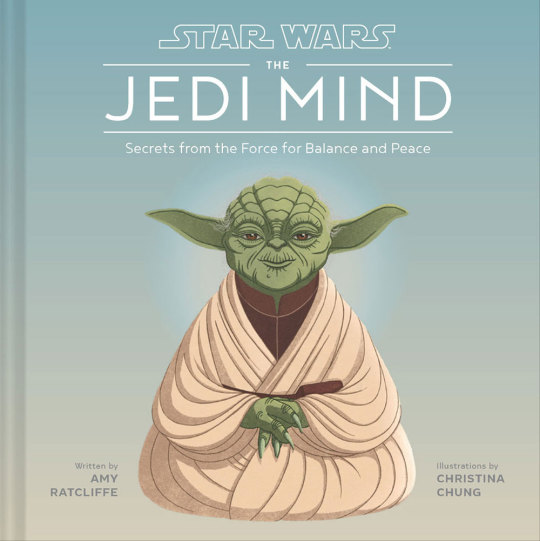

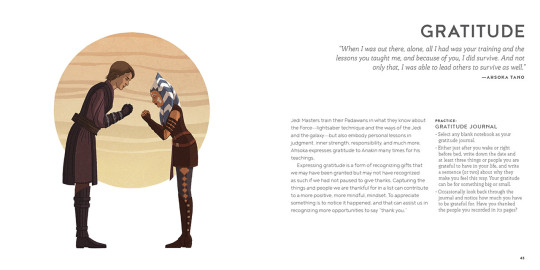
Star Wars: The Jedi Mind takes quotations and lessons from Star Wars and pairs them with practices such a breathing, posture, and meditation. The Jedi Code is focused on peace, knowledge, serenity, and balance—principles that readers can engage in their own lives. The philosophical tenets are applicable not just in the galaxy far, far away, but also in our own galaxy, here and now.
Quoted wisdom offers day-to-day life lessons
An accessible pop culture spin on the Star Wars universe
Features 20 color illustrations to illuminate the book's thoughtful advice
"Trust your feelings."—Obi-Wan Kenobi Star Wars: The Jedi Mind is the perfect gift for Star Wars fans looking for balance, and seekers of inner calm open to learning from the Jedi Masters.

YOUR FOCUS DETERMINES YOUR REALITY IN THE JEDI MIND — EXCLUSIVE Breathe. Just breathe. Reach out with your feelings. What do you see? Mindfulness is as much a part of the fabric of Star Wars as the Force itself, guiding characters to pause, reflect, and get in touch with their feelings as well as their surroundings. So it seemed like a natural fit as Amy Ratcliffe was exploring the topic for her new book, The Jedi Mind. Part self-guided mindfulness primer and part appreciation of the practice of mindfulness woven throughout the Jedi teachings, the book is paired with beautiful illustrations from artist Christina Chung to give readers bite-sized meditations on everything from letting go to looking inward. StarWars.com is pleased to give you your first look at the cover as well as pages and passages on gratitude and more! Plus, we sat down with the author to discuss what inspired her to link her own practice of mindfulness to the Jedi mind and how she hopes the book can help readers and fans who are new to the idea. Before we clear our minds of questions, here’s what Ratcliffe had to say to a few of ours… StarWars.com: Fictional stories can be such an important tool for understanding our own feelings as well as universal experiences and ideas. What inspired you to start thinking about mindfulness and how it’s exhibited in the Star Wars saga? Amy Ratcliffe: It started with meditation. Pausing to meditate and breathe opened the door to mindfulness for me. It’s just one of the many ways to practice mindfulness, but it’s the cornerstone for me. Whenever I would meditate, I would think about the Jedi. Specifically, I think of Qui-Gon Jinn dropping to a seated position and meditating during his battle with Darth Maul in Star Wars: The Phantom Menace. The first time I saw the movie I was so surprised by that. Like, “Buddy, what are you doing right now?!” But as I sank deeper into the world of Star Wars, I realized how much sense it made for Qui-Gon — specifically Qui-Gon — to pause when he had a chance and be in the moment. Then as I thought more about that I considered the Force and how the Jedi teach others about it and the things Jedi say about the Force. Obviously the Force doesn’t exist in our lives and mindfulness is not called out in Star Wars, but they pair together beautifully. StarWars.com: I love that you connect a quote, character, or moment to a real-life aspect of mindfulness on each page and include a suggested practice. As a self-proclaimed worrier, do you have a favorite passage or page? Can you talk about why it speaks to you so profoundly? Amy Ratcliffe: Mindfulness helps me stay more centered, but I’m always going to worry. I can spiral like a champ. Writing this book and going through all the practices repeatedly meant I really got to learn which ones work the best for me. One thing I struggle with is how I react to situations around me and how I allow external forces to affect me — particularly the ones I can’t control. In Star Wars Rebels Bendu told Kanan, “Only you can change yourself.” I connected that moment to a self-acceptance meditation. Kanan was carrying so much weight on his shoulders, particularly after his battle with Maul and losing his eyesight, and Bendu’s guidance helped Kanan accept himself as he was. That really hit me. StarWars.com: It’s also important to note that you can really jump around in this book. You could read it in one sitting or pick a few pages at random, or even bring it into your yoga practice and read one page before starting each session. Why was it important to you to structure it this way? Amy Ratcliffe: I didn’t want the book to be daunting. Especially if someone isn’t sure about mindfulness or how to approach it. Mindfulness is a vast world; it can be hard to know where to start. And while I absolutely encourage anyone interested in learning more to do so, The Jedi Mind goes over mindfulness basics and then it’s kind of like a sampler platter (which is always a terrific choice when you can’t decide on a single appetizer). Pick the book up, admire a soothing illustration, read a quote tied to the Force, and learn how to adapt it for practical use. Maybe you’ll skip around a few pages before finding one that catches your eye. Maybe you’ll want to go page by page and try everything. It’s about whatever works best for your style! StarWars.com: Christina Chung’s illustrations are also just gorgeous! We have two pages to share today. Can you tell us a little bit about each one and your collaboration with the artist? Amy Ratcliffe: I almost just suggested skipping through to look at all the illustrations first because Christina’s work is so beautiful! So, do that. Christina contributed to Star Wars: Women of the Galaxy, and when my editor and I started discussing what kind of illustrations would be in The Jedi Mind, we knew she would be perfect. As I wrote the text, I made suggestions for characters and possible poses for every quote and practice. I didn’t know which ones we’d end up illustrating, so I wanted to cover my bases. For “Gratitude,” I gave a very basic note like, “Anakin and Ahsoka.” That was it. So helpful. With “See What is There” I suggested Maz Kanata peering through her goggles as she did in Star Wars: The Force Awakens. And in both of those cases, Christina took those suggestions and made them blossom. She chose such calming color palettes and all her strokes are elegant and truly elevate the text. Her work adds such a unique factor to the book. I’m so grateful she was willing and available to contribute. StarWars.com: What do you hope fans and readers will get out of this book? Amy Ratcliffe: My wish is that readers find at least one practice to help them savor a moment. To experience it fully. Because mindfulness isn’t about zoning out, it’s about tuning in with all our attention. And to readers unfamiliar with mindfulness, my hope is that framing practices in the context of Star Wars will encourage them to take their first steps into a larger world.
#anakin skywalker#ahsoka tano#maz kanata#qui gon jinn#jedi#news#novels#waiting for amy ratcliffe to shit on every jedi except anakin ahsoka and qui gon is going to be fun sigh
180 notes
·
View notes
Text
March 2, 2021: The Last Unicorn (1982) (Part 1)
I, uh...I wanna talk about zoology.

It’s my profession of choice, although if I’m going to be specific, it’s ecology and ornithology, based on my Masters. But while my expertise is in birds, that doesn’t mean I have any particular preference. So, let’s talk mammals. Specifically, I’d like to talk about horses.

Horses are odd-toed ungulates (Order Perissodactyla) belonging to the family Equidae, with only one living genus (Equus), which includes donkeys, zebras, and a FUCK-ton of fossil progenitors. Not gonna go into horse evolution here, since it’s a vast topic on its own, but the group dates to about 54 million years ago, during the Eocene period.
There are specific features that define modern horses as horses, including a single hoofed toe for walking on, a body built for running with high stamina, and a large cecum in the intestines for breaking down fibrous and herbaceous material. It’s a group native to North America, Africa, and Asia, with the modern descended horse descended from a somewhat unknown ancestor in Central Asia.

They’re grazers rather than browsers, which many similar sized herbivores are. And, of course, they have a close relationship to humans throughout prehistory. Their main systems of defense against predators are the afore-mentioned running capabilities, a VICIOUS kick (especially horses like zebras), and a high-range of monocular vision due to the position of their HUGE eyes.
In terms of sexual selection, it’s essentially based on physical competition between the males in a population, which are usually formed into reproductive harems. That’s one male with multiple females that live within an established range. The females have their own dominance schemes, while groups of males exist in bachelor herds before establishing a harem of their own.
And those two paragraphs help explain why horses don’t grow horns.

Animals like this bighorn sheep, as well as antelopes with impala and gerenuk, perform intrasexual selection using their horns, the size of which determine the fitness of an individual male, with the fights settling any potential ties for watching females. And that’s the main reason why herbivorous mammals grow horns, and horses have come up with different social structures to compensate. But OK, couldn’t they just horns anyway?
Remember the stomach I mentioned earlier? Here’s the thing; hindgut digestion, which is what horses do...not the most nutritionally efficient form of digestion. In order to maintain their running lifestyles, they invest all obtained energy and nutrients into building muscle and other important functions. Fact of the matter is, they just can’t devote enough energy and nutrients to the physiologically expensive act of owning a horn. They do have a close relative that does that, though. However, they’ve sacrificed their speed, intelligence, and even their eyesight for their horns, as well as beefing up their physical defense with thicker skin.

YUP! So why talk about this? I mean...you know why.

OK, so that had basically nothing to do with this movie, but a post like this has been building since I mentioned the gerenuk a little bit ago. Sorry, had to get it out. Anyway, yeah, unicorns are impossible, but they’re still a hallowed mythical creature. National animal of Scotland, one of the most prominent symbols of medieval mythology, a magic-using ethnic class in a mythical kingdom composed of a horse-based majority that also includes normal horses and pegasi...

You know, unicorns. So, I’m definitely interested in what would happen to make a unicorn, well...the last one. My bets are on something man-made, like deforestation or another for of habitat depletion. Could be poaching for the horn. After all, that’s what’s been driving rhinoceros species to near-extinction (or actual extinction in the case of the western black and northern white rhinos. RIP Sudan, you goddamn king).
But let’s find out rather than speculate! SPOILERS AHEAD!!!
Recap (1/2)
During medieval times, in a mystical wood called the Unicorn’s Forest, a hunter shows unease to his companion. In the forest, there are no seasons, and the beasts are protected from hunters, as long as there is one unicorn left if the forest. That last unicorn is...the Unicorn (Mia Farrow), who learns from the hunters that she must be the last of her kind.
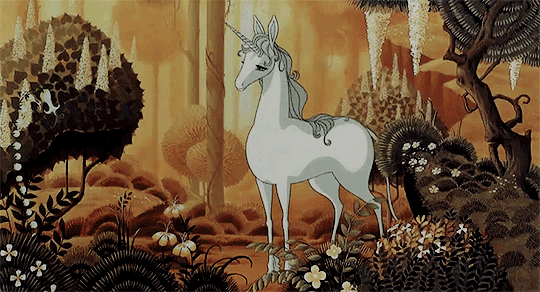
The opening credits, which are a gorgeous animated medieval tapesty, are backed by the song “The Last Unicorn”, by America (damn, nice pull). Gives the whole thing a Renn Faire feel. Never been to a Renn Faire, but I’d love to go to one, honestly.
Anyway, the Unicorn is in doubt that there are no more of her kind in the world, as they live forever, and she would know if there are none left...right? However, they can also be killed and trapped, so...I mean, they might be dead, Unicorn. As she’s thinking on this, the most Rankin-Bass butterfly ever shows up singing a ballad of love. This is...the Butterfly (Robert Klein), a bard-erfly (see whay I did there) who won’t stop singing, despite the Unicorn’s pleas to tell her of other unicorns.
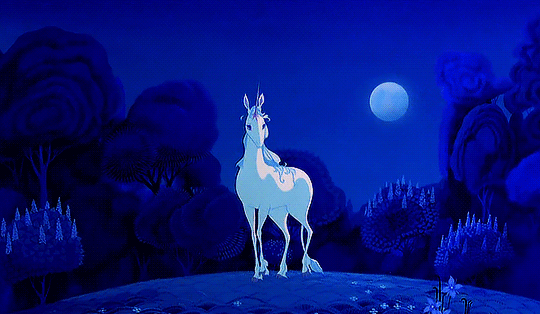
Butterflies, apparently, repeat to anything they hear around them Which involves like, a lot of non-medieval songs. There’s one about the A-train, apparently, which makes...just NO fucking sense. As the Unicorn also shows frustration at this anachronistic little bugger, he breaks his songs to tell her than the Unicorns have all been chased off by “the Red Bull.”
...I’m going to hold it off as long as I can, but the joke WILL come. It WILL come.
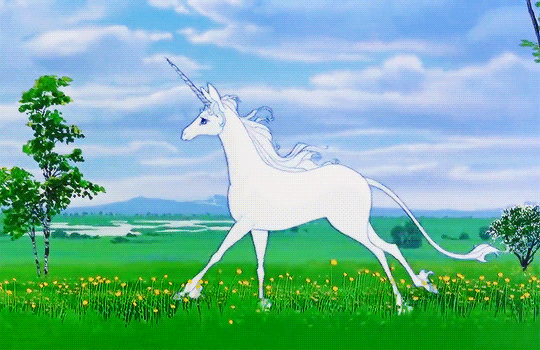
She wonders if she can truly leave the forest, then actually does so in order to find the other unicorns. She happens upon a farmer, who attempts to tame her, as he only sees her as a horse. Apparently, men can no longer see unicorns as they are, and usually only see them as white horses. So, there may be unicorns in the world after all!
Not sure why she doesn’t go back to her forest after realizing this, but...OK. She continues on, backed once again by a song performed by America, called “Man’s Road”. Real talk, I’m digging the music in here, which is my inner folk rock fan talking.

While she finds nothing on her journey, she’s instead found by Mother Fortuna (Angela Langsbury), a witch who runs a carnival that needs a new exhibition. With her comes Ruhk (Brother Theodore) and magician Schmendrick (Alan Arkin), the latter of whom actually can see the Unicorn as a Unicorn.
At the carnival, Schmendrick introduces hiself to the Unicorn, wanting to get her out of there. Meanwhile, an audience is fooled by Mother Fortuna’s illusory magic to see a manticore, satyr, and the Midgard Serpent, when in reality they are an elderly lion, ape with a twisted foot, and really sad snake. However, the Harpy that she has IS real, and a major threat to Fortuna were she to escape.

That night, Fortuna speaks to the Unicorn of the Red Bull, owned by a King Haggard. The Unicorn asks Fortuna to free both her and the Harpy, two signs of the same magical coin. Also...is this a kids’ movie? Kinda thought it was until I noticed that the Harpy has, well...pendulous breasts. Literally the best way I can describe them. Also, three of them, so...there’s that.
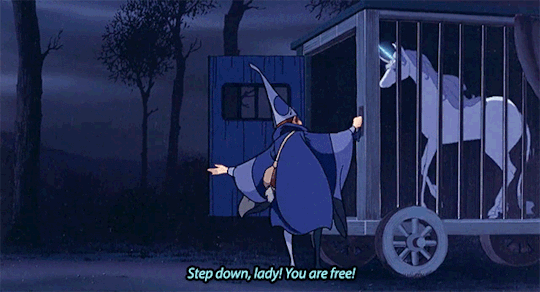
After she leaves, Schmendrick arrives to free the Unicorn with his magic...and he’s shit at it. Like, REALLY shit. But thankfully, he’s a decent pickpocket, and stole the cage keys from Ruhk. He lets the Unicorn free, and she in turn releases the other animal prisoners, Harpy included. Which is NOT great for Fortuna, who’s IMMEDIATELY killed.
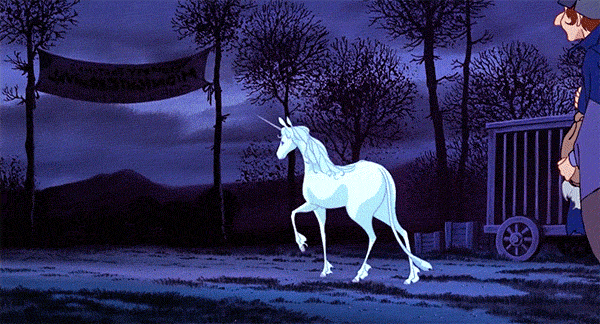
The two leave together, and head on the Unicorn’s journey to find her own kind. She cannot grant Schmendrick his wish to become a true magician, but he still gives her information about this world, and King Haggard, who seems like bad news.
On the road, the two encounter a gang of thieves of the road, who work for Captain Cully (Keenan Wynn), a short and portly leader of bandits. His mistress is a woman named Molly Grue (Tammy Grimes), who’s endlessly frustrated by Cully’s regular failures. They befriend Schmendrick, who impresses them with illusions of Robin Hood and his Merry Men. Although, it’s not his illusions, but those of the Unicorn, trying to help.
Doesn’t help that much, though, as the Robin Hood-hating Captain Cully ties him up to a tree after all of his men and Molly leave. A frustrated Schmendrick mutters a spell by mistake, and brings the tree to life.
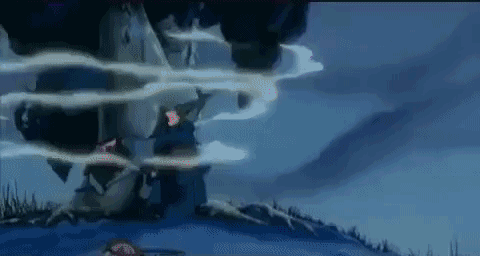
And then my girlfriend fuckin’ broke. Here she is, below:

Ravishing. Yeah, she’s watching this too, and when the tree came up, her words were, and I quote:
...a smooth-talking horse, a three-tittied harpy, and a BOOBED TREE!
Boobed tree is an expression I will find a way to use in my life. Also, this is ABSOLUTELY not a kid’s movie, and that is one busty-ass tree. This tree, called...The Tree (Nellie Bellflower) is in love with Schmendrick, and is enraged by the appearance of the Unicorn. However, the Unicorn undoes Schmendrick’s magic, and puts the t-horny tree back to sleep.
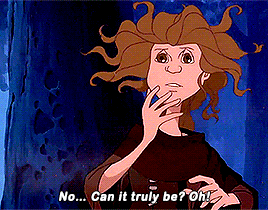
The two encounter Molly Grue, who’s astonished to see a Unicorn. She cries, as she was been waiting to see one since she was a young maiden, but now she isn’t one anymore. Interesting implications there, but moving on. Molly wishes to join them, and while Schmendrick isn’t super down for that, she wins the Unicorn’s trust when she points out that they’ve been going in the wrong direction. Whoops.
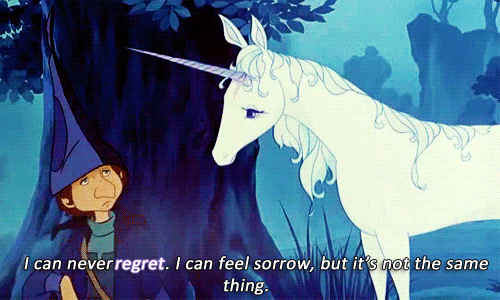
OK, with that, let’s break for Part 2! See you there!
#the last unicorn#peter beagle#arthur rankin jr.#jules bass#rankin bass#rankin-bass#alan arkin#jeff bridges#mia farrow#tammy grimes#robert klein#angela langsbury#christopher lee#keenan wynn#paul frees#rene auberjonois#the unicorn#user365#365 movie challenge#365 movies 365 days#365 Days 365 Movies#365 movies a year#mygifs#my gifs
13 notes
·
View notes